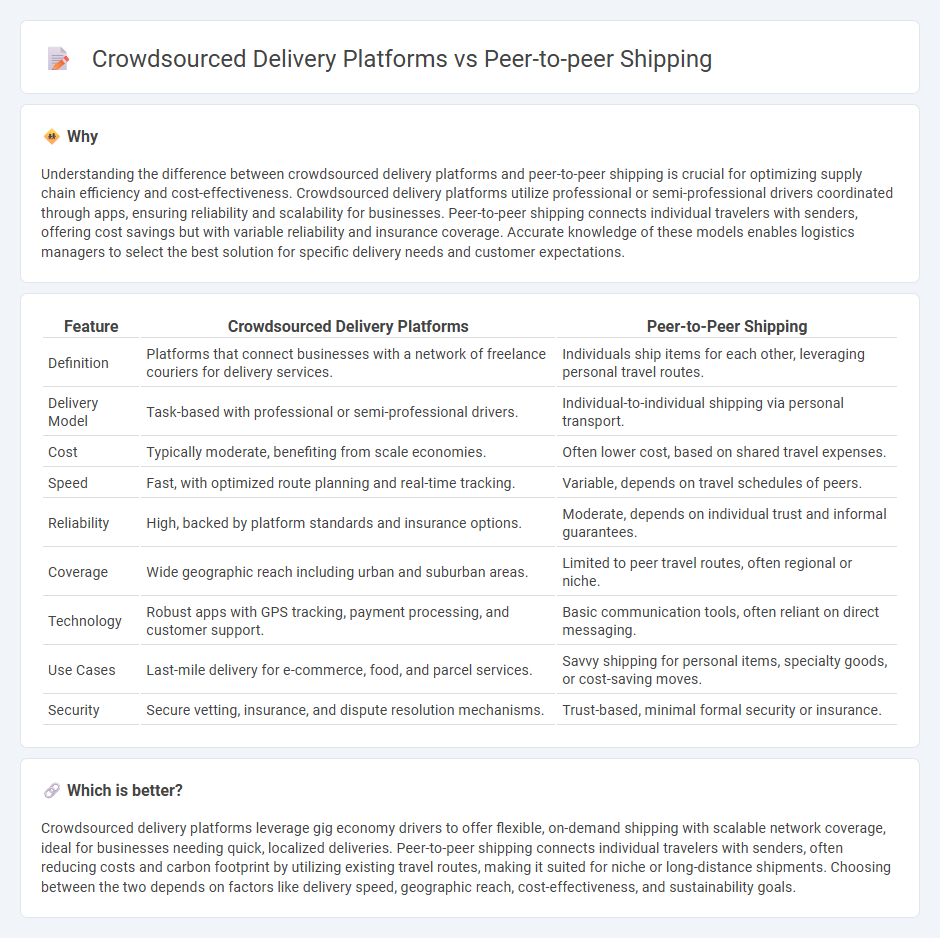
Crowdsourced delivery platforms leverage a network of non-professional couriers to fulfill last-mile logistics, reducing costs and enhancing delivery speed by utilizing underused resources. Peer-to-peer shipping enables individuals to send packages through personal travelers or local residents, optimizing route efficiencies and fostering community-based commerce. Discover how these innovative models reshape logistics by exploring their operational advantages and challenges.
Why it is important
Understanding the difference between crowdsourced delivery platforms and peer-to-peer shipping is crucial for optimizing supply chain efficiency and cost-effectiveness. Crowdsourced delivery platforms utilize professional or semi-professional drivers coordinated through apps, ensuring reliability and scalability for businesses. Peer-to-peer shipping connects individual travelers with senders, offering cost savings but with variable reliability and insurance coverage. Accurate knowledge of these models enables logistics managers to select the best solution for specific delivery needs and customer expectations.
Comparison Table
| Feature | Crowdsourced Delivery Platforms | Peer-to-Peer Shipping |
|---|---|---|
| Definition | Platforms that connect businesses with a network of freelance couriers for delivery services. | Individuals ship items for each other, leveraging personal travel routes. |
| Delivery Model | Task-based with professional or semi-professional drivers. | Individual-to-individual shipping via personal transport. |
| Cost | Typically moderate, benefiting from scale economies. | Often lower cost, based on shared travel expenses. |
| Speed | Fast, with optimized route planning and real-time tracking. | Variable, depends on travel schedules of peers. |
| Reliability | High, backed by platform standards and insurance options. | Moderate, depends on individual trust and informal guarantees. |
| Coverage | Wide geographic reach including urban and suburban areas. | Limited to peer travel routes, often regional or niche. |
| Technology | Robust apps with GPS tracking, payment processing, and customer support. | Basic communication tools, often reliant on direct messaging. |
| Use Cases | Last-mile delivery for e-commerce, food, and parcel services. | Savvy shipping for personal items, specialty goods, or cost-saving moves. |
| Security | Secure vetting, insurance, and dispute resolution mechanisms. | Trust-based, minimal formal security or insurance. |
Which is better?
Crowdsourced delivery platforms leverage gig economy drivers to offer flexible, on-demand shipping with scalable network coverage, ideal for businesses needing quick, localized deliveries. Peer-to-peer shipping connects individual travelers with senders, often reducing costs and carbon footprint by utilizing existing travel routes, making it suited for niche or long-distance shipments. Choosing between the two depends on factors like delivery speed, geographic reach, cost-effectiveness, and sustainability goals.
Connection
Crowdsourced delivery platforms and peer-to-peer shipping both leverage decentralized networks to optimize logistics by connecting individual senders with local couriers, reducing reliance on traditional carriers. These systems utilize real-time tracking, route optimization, and mobile technology to increase efficiency and lower costs while enhancing flexibility in last-mile delivery. As a result, the integration of these models supports sustainable logistics by minimizing delivery times and carbon footprints through shared transportation resources.
Key Terms
Decentralization
Peer-to-peer shipping leverages decentralization by enabling direct exchanges between users, bypassing traditional logistics intermediaries and reducing costs while increasing flexibility. Crowdsourced delivery platforms also utilize decentralized networks but rely on a centralized app or platform to coordinate and manage drivers or couriers. Explore the key differences and benefits of decentralization in these models to understand their impact on the future of shipping and delivery.
Real-time matching
Peer-to-peer shipping platforms leverage real-time matching algorithms to connect individual shippers with available carriers, optimizing route efficiency and delivery speed by utilizing idle transport capacity. Crowdsourced delivery platforms employ dynamic algorithms to match customer delivery requests with a distributed network of local couriers, enhancing last-mile delivery through immediate availability and geographic proximity. Explore how these real-time matching technologies revolutionize logistics efficiency and customer satisfaction.
Gig economy
Peer-to-peer shipping leverages individual users to transport packages directly between senders and receivers, reducing reliance on traditional carriers, while crowdsourced delivery platforms utilize a broad network of freelance couriers to fulfill deliveries rapidly and flexibly. Both models thrive on the gig economy, offering part-time workers opportunities for income via digital platforms that match supply and demand efficiently. Explore how these innovative delivery solutions reshape logistics and empower gig workers in today's market.
Source and External Links
What is Peer to Peer International Shipping? - Air Sea Containers - Peer-to-peer international shipping involves individual travelers transporting packages to their destinations, often making it a cheaper and more efficient alternative for small, lightweight items compared to traditional shipping methods.
Carrycome - P2P Courier Service - Carrycome offers a peer-to-peer system connecting travelers and senders, enabling quick and secure package deliveries worldwide through its platform and app.
Peer to Peer Delivery, P2P Delivery On Demand - GoShare - GoShare connects people needing to move or deliver large items with truck and van owners, providing an on-demand peer-to-peer delivery network that is flexible, insured, and cost-effective.
 dowidth.com
dowidth.com